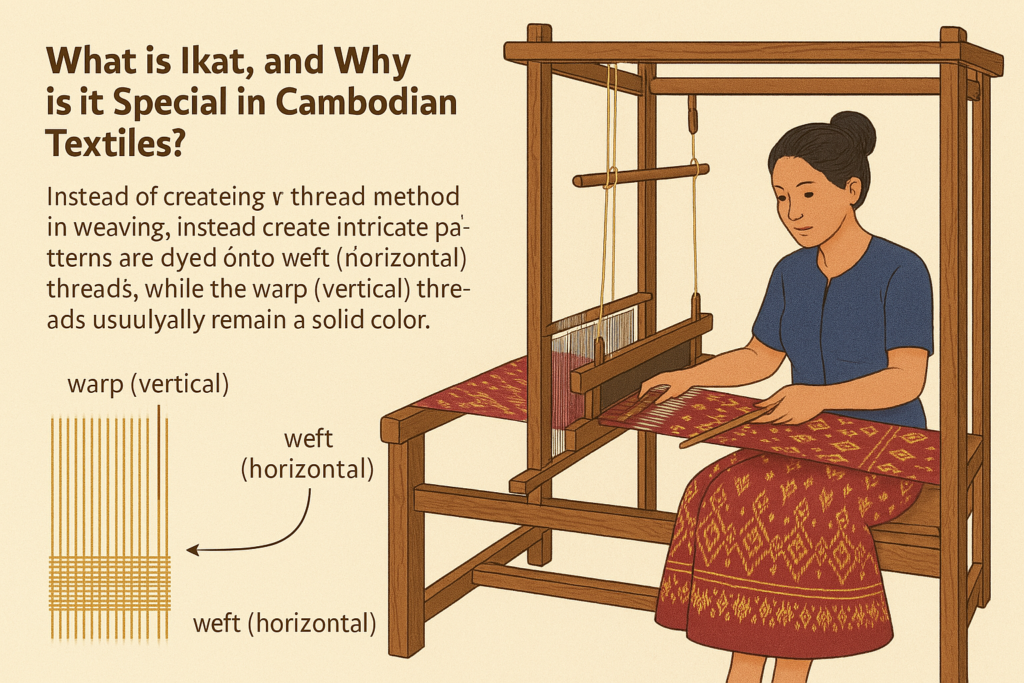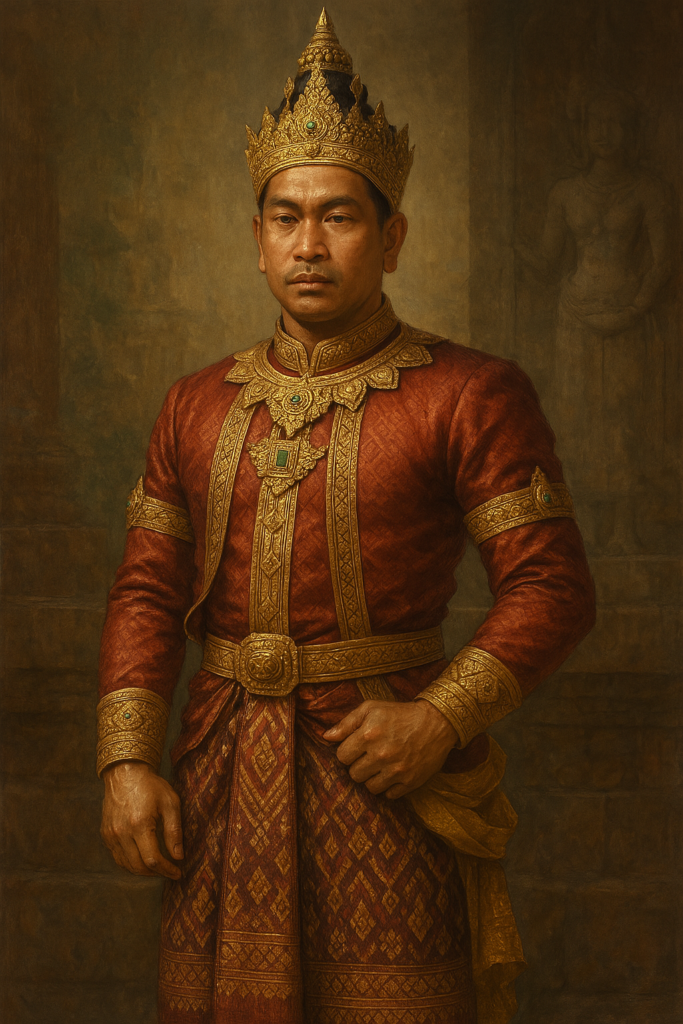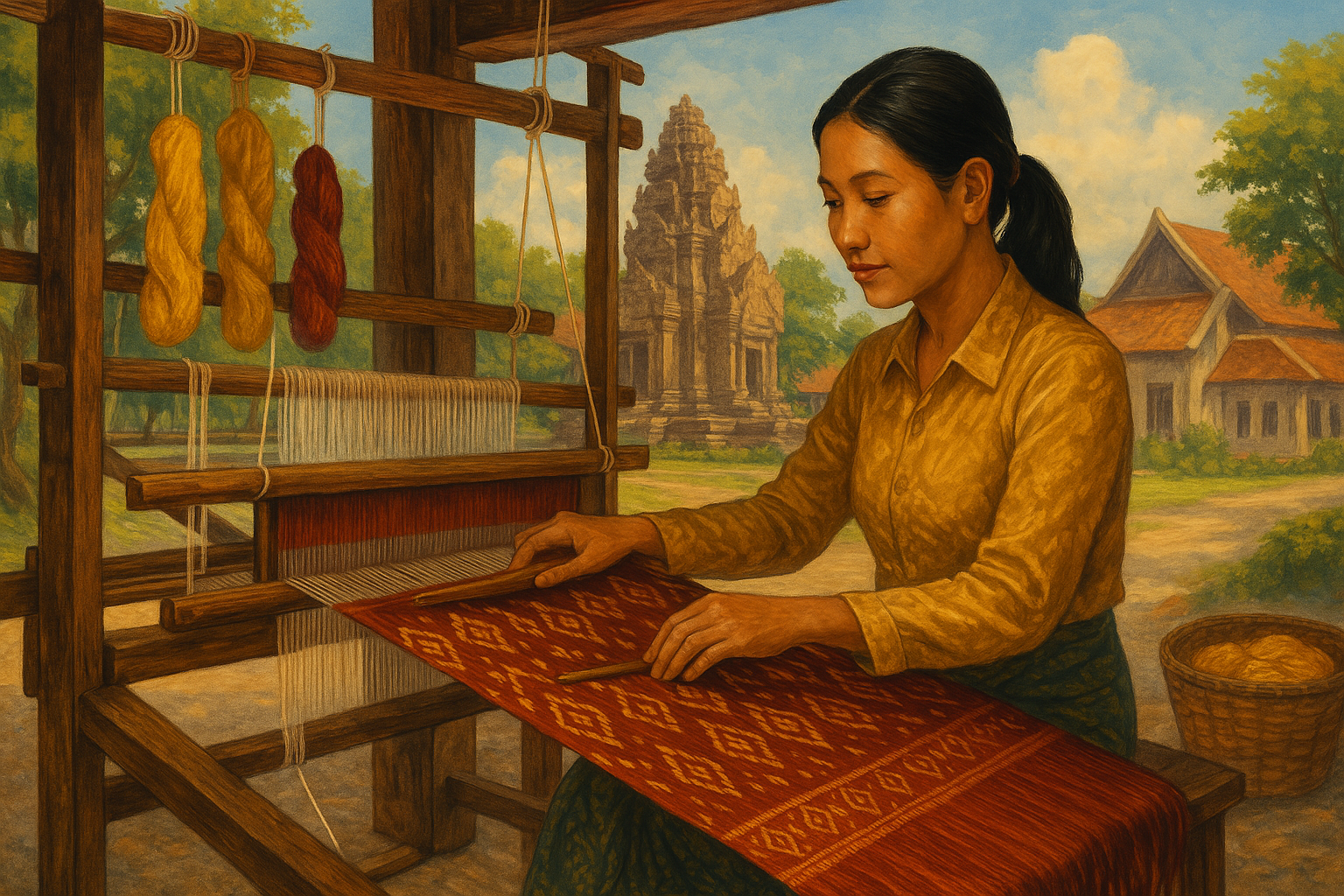Among the rich tapestry of Cambodian textiles, one technique stands out for its complexity, beauty, and cultural prestige: Ikat. Known locally as Chong Kiet (ចងគៀត), meaning “to tie,” this intricate method of resist-dyeing threads before they are woven is responsible for creating the highly prized Cambodian silk skirts known as Sampot Hol (សំពត់ហូល). Mastering Ikat requires immense skill, patience, and artistry, making it one of the most revered and valuable textile traditions in the Kingdom.
What is Ikat, and Why is it Special in Cambodian Textiles?

Ikat (a term borrowed from the Malay/Indonesian word for “to tie” or “to bind”) is fundamentally different from other pattern-making techniques in weaving. Instead of creating designs by adding colored threads during weaving (like tapestry) or decorating the finished cloth (like embroidery), Ikat involves patterning the threads themselves through a meticulous process of binding and dyeing before weaving begins. In Cambodia, this is primarily weft ikat, meaning the intricate patterns are dyed onto the weft (horizontal) threads, while the warp (vertical) threads usually remain a solid color.
The magic and challenge of Ikat lie in the pre-planning and precision required. The weaver must calculate and dye the pattern onto the threads with extraordinary accuracy so that when woven, these threads align perfectly, row by row, to reveal the intended complex motif. This inherent difficulty often results in a characteristic slight “blurriness” or “feathering” at the edges of the patterns, considered a hallmark of authentic handwoven Ikat. The sheer labor and skill involved make Ikat textiles, particularly silk Sampot Hol, highly valued symbols of artistry and status in Cambodia.
How Ikat Weaving Differs from Other Weaving Styles
- Plain Weave: Patterns are created simply by using different colored warp and/or weft threads in basic over-under interlacing (like stripes or checks). The pattern structure is part of the basic weave.
- Tapestry Weave: Different colored weft threads are used in sections to build up blocks of color, often creating pictorial designs. The weft threads do not run all the way across the fabric width.
- Brocade/Supplementary Weft: Extra pattern threads are woven into the base fabric during the weaving process to create raised or contrasting designs.
- Embroidery: Decorative stitches are added to the surface of an already woven fabric.
Ikat is unique because the potential pattern exists within the dyed threads before the loom is even set up. The weaver’s ultimate skill lies in bringing that pre-planned pattern into sharp focus through meticulous alignment during the weaving process.
The Complex Process of Dyeing and Weaving Ikat Patterns
Creating Cambodian Ikat (Chong Kiet) is a multi-stage, painstaking process:
- Bundling Threads: Bundles of natural silk weft threads are prepared, the thickness depending on the desired fineness of the final fabric.
- Tying Resists: Skilled artisans tightly wrap sections of these bundles with resist materials (traditionally banana fibers, now often plastic strips or nylon) according to a predetermined, often memorized, pattern. These wrapped sections will resist the dye.
- Dyeing: The tied bundles are immersed in dye baths. Traditionally, natural dyes from local plants, bark, fruits (like ebony), and minerals were used, requiring expert knowledge. The unwrapped sections absorb the color.
- Untying and Re-tying: After dyeing and drying, the resist ties are removed. If the pattern requires multiple colors, the process is repeated: new sections are tied off, and the bundles are dyed in a different color. This multi-color Ikat is exceptionally complex and time-consuming.
- Preparing for Weaving: Once all dyeing is complete, the now-patterned weft threads are carefully untied, ordered, and wound onto bobbins or shuttles.
- Weaving: The weaver sets up the plain silk warp threads on a traditional handloom. Then, with intense concentration, they weave the patterned weft threads, meticulously adjusting each pass of the shuttle to ensure the pre-dyed sections align correctly and the intricate motif emerges clearly from the interlacing threads.
Woven Narratives: Famous Cambodian Ikat Designs and Their Symbolism

Sampot Hol feature a diverse range of traditional motifs, rich with cultural meaning:
- Mythological Figures: The Naga (នាគ), a mythical serpent deity associated with water, protection, and royalty, is a very common and powerful motif. The Hang (ហង្ស), a mythical bird resembling a phoenix or swan, symbolizing grace and nobility, also appears.
- Floral Motifs: Designs inspired by local flora like jasmine (pka chan – ផ្កាម្លិះ) or lotus buds (pka chouk – ផ្កាឈូក) are frequent, often symbolizing purity, beauty, and Buddhist enlightenment.
- Geometric Patterns: Diamonds, zigzags, stars, and intricate lattice-like designs are widely used, potentially representing elements of nature, cosmology, or ancient protective symbols.
- Animal Motifs: Birds, elephants, or other animals may feature, sometimes carrying specific symbolic weight within folklore. The precise meanings can be complex and sometimes vary by region or weaving lineage, but they consistently connect the textiles to Khmer cosmology, spirituality, and the natural world.
Threads of Nobility: Ikat and Royal Garments in Khmer History

Historically, the sheer amount of time, resources (fine silk, complex dyes), and exceptional skill required to produce high-quality Sampot Hol made them luxury items accessible primarily to the royal court and the aristocracy. Elaborate Ikat silks were integral to royal regalia and court ceremonies, signifying status, wealth, and refined taste. Wearing Sampot Hol marked one as belonging to the upper echelons of society. These prized textiles were also likely used as prestigious diplomatic gifts, showcasing the kingdom’s artistic prowess.
Guardians of the Loom: The Role of Women in Preserving Ikat Weaving Traditions

In Cambodia, the intricate art of Ikat weaving is overwhelmingly a female domain. Women are the primary practitioners and custodians of this demanding craft. From calculating and executing the complex tie-dyeing sequences to the patient, meticulous work at the loom, the knowledge and skills are traditionally passed down through generations, typically from mothers to daughters within weaving communities. While men might be involved in building looms or aspects of sericulture, the core artistry and technical mastery of Chong Kiet reside with women. They are the vital link ensuring the continuity of this significant element of Cambodia’s intangible cultural heritage.
Conclusion
Cambodian Ikat weaving, or Chong Kiet, represents a remarkable fusion of technical mastery and artistic expression. The creation of Sampot Hol through this complex resist-dyeing and weaving process results in textiles that are not only visually stunning but also deeply embedded in Khmer history, symbolism, and social structure. Although facing challenges in the modern era, the enduring legacy of Ikat, historically tied to royalty and primarily preserved through the dedicated hands of women artisans, remains a crucial and cherished part of Cambodia’s cultural landscape. Recognizing the artistry of Ikat is essential to appreciating the depth of Khmer heritage, a heritage still actively valued in communities across the nation, including cultural hubs like Battambang, as of 2025. Sources and related content





